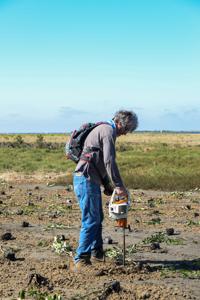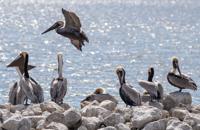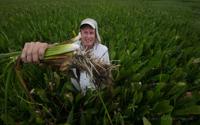On Louisiana’s coast, a second effort to plant Queen Bess Island for pelicans
Volunteers install 6,000 black mangrove shrubs and matrimony vines
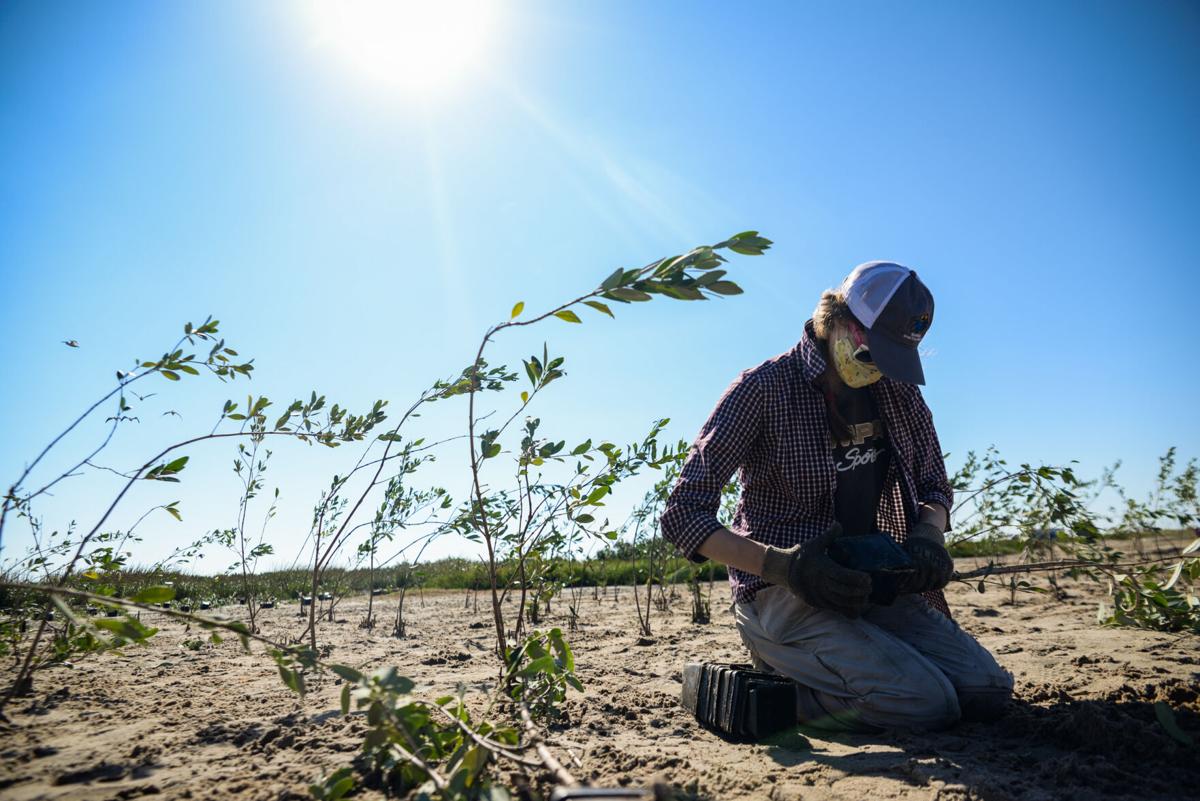
Nicholls State University graduate student Katie Gray works to pull a black mangrove seedling from its plastic pot during a volunteer planting on Queen Bess, Friday, Nov. 13, 2020. (Photo by Halle Parker, NOLA.com, The Times-Picayune | The New Orleans Advocate)
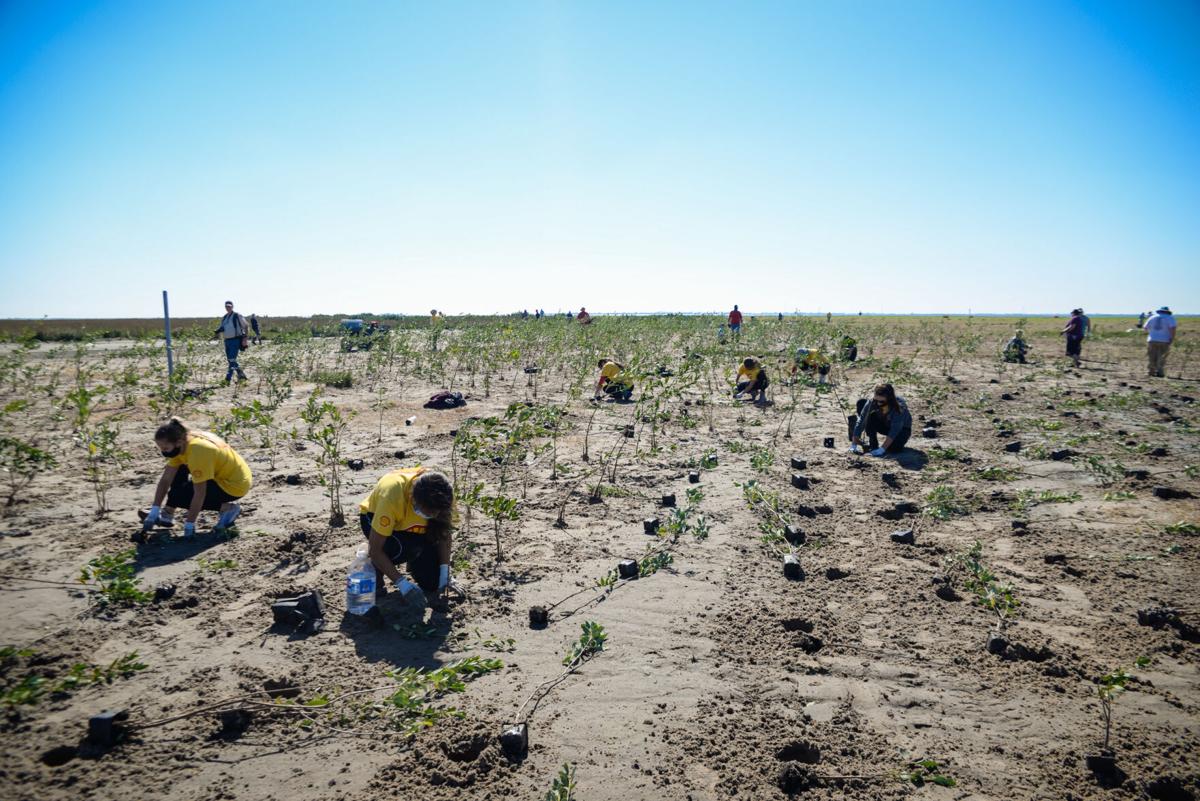
Nicholls State University student-athletes clad in yellow Shell-sponsored shirts work to plant rows of black mangrove on Queen Bess, Friday, Nov. 13, 2020. (Photo by Halle Parker, NOLA.com, The Times-Picayune | The New Orleans Advocate)
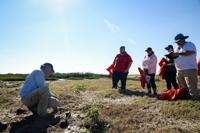
Barataria-Terrebonne National Estuary Program habitat restoration coordinator Matt Benoit demonstrates how to plant black mangrove and matrimony vine seedlings during the first volunteer planting on Queen Bess, Friday, Nov. 13, 2020. (Photo by Halle Parker, NOLA.com, The Times-Picayune | The New Orleans Advocate)
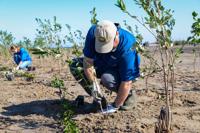
Louisiana Coastal Protection and Restoration Authority Executive Director Bren Haase pats dirt down and around a black mangrove on Queen Bess Friday, Nov. 13, 2020. (Photo by Halle Parker, NOLA.com, The Times-Picayune | The New Orleans Advocate)
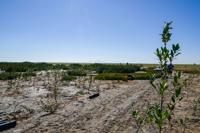
Some of the some of the black mangroves lean after being planted on Queen Bess, Friday, Nov. 13, 2020. (Photo by Halle Parker, NOLA.com, The Times-Picayune | The New Orleans Advocate)
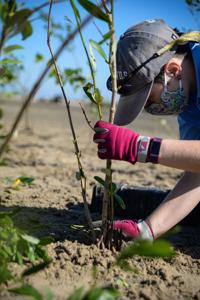
Nicholls University student Claire Boudreaux tucks sand around a young black mangrove during the first volunteer planting on Queen Bess, Friday, Nov. 13, 2020. (Photo by Halle Parker, NOLA.com, The Times-Picayune | The New Orleans Advocate)

Barataria-Terrebonne National Estuary Program public involvement coordinator Seth Moncrief drives more trays of matrimony vine to volunteers on Queen Bess Island, Friday, Nov. 13, 2020. (Photo by Halle Parker, NOLA.com, The Times-Picayune | The New Orleans Advocate)
After Louisiana officials finished restoring 37-acre Queen Bess Island in February, much of the vegetation planted on its small footprint of newly pumped sand didn’t have time to take root before more than 6,000 brown pelicans arrived for breeding season. The birds pulled up some sprouts to use in their nests.
So on Friday, the squawks of a few lingering pelicans mixed with the hum of drills boring shallow holes in the island’s surface, preparing spots for about 50 volunteers to plant another 6,000 seedlings on the state’s newest wildlife refuge.
Matt Benoit, who coordinates habitat restoration for the Barataria-Terrebonne National Estuary Program, demonstrated how to take young black mangrove shrubs and matrimony vines out of their plastic pots and place them in the drilled holes.
“You have to pack the sand around the roots real tight. They don’t like any air down there,” he said as he pulled sand around a mangrove seedling. His agency brought about 1,500 of the plants, while Nicholls State University’s farm provided about 200 and the Louisiana Department of Wildlife and Fisheries Foundation supplied the remainder.
Todd Baker, the Louisiana Department of Wildlife and Fisheries‘ coastal resource scientist manager for wildlife, said the goal was to secure the plants with enough time for them to bolster nesting habitat ahead of the pelicans’ next nesting season three months hence.
“We could allow the island to naturally vegetate, but it’s going to take years for it to do it, so this is a good way to give it a jump start,” he said. “We’re losing a lot of pelican nesting habitat all around, so the more we can provide it here, the more it substitutes for the habitat being lost.”
Queen Bess, which provides 70% of Louisiana’s pelican nesting habitat, benefitted from $18.7 million provided by the BP oil disaster settlement. The island and its feathered inhabitants, located in Barataria Bay about two miles north of Grand Isle, were some of the first to be oiled after the Deepwater Horizon explosion in 2010. The island’s population of brown pelicans, Louisiana’s state bird, had climbed its way back after a 1960s decline caused by the widespread use of the since-banned pesticide DDT.
“To see that money go right back into this habitat and for those exact birds is significant,” Baker said. “And then to see these organizations come together to make another investment in this island is pretty special. It’s not very often we get to do bird projects at this kind of scale.”
As the native mangroves and vines grow, the pelicans build their nests on top, squishing the plants slightly when they sit and care for their eggs. The plants also help hold sand in place, limiting erosion caused by the wind and water.
Between the coronavirus pandemic and the record-breaking 2020 hurricane season, Baker said, there was a lot of uncertainty around whether Friday’s event would continue. That uncertainty only increased as Hurricane Eta approached the Gulf of Mexico, though the storm ultimately struck Florida.
Despite the number of storms this year, including a direct hit from Hurricane Zeta two weeks ago, executive director Bren Haase, of the Louisiana Coastal Protection and Restoration Authority, said the restored island fared well, with only a couple areas showing minor erosion and some water still held on the island. Other restoration projects that were still under construction, such as marsh-building efforts near Port Fourchon on West Belle Pass and at Caminada Headlands, were the most damaged.
While restoration project surveys continue, Haase said, “what we found generally just from looking at aerial photography is that projects that were done actually did pretty well.”
While tucking a black mangrove into the ground, Nicholls State graduate student Katie Gray said she was drawn to Friday’s event to “do her part” to address the state’s land loss crisis. Because of Louisiana’s rapidly eroding coastline, “us planting these black mangroves to stabilize these barrier islands is so important,” she said.
Haase said the volunteer turnout showed “what the coast brings out in the souls of Louisiana.”
“These people are all out here on a work day on their own time volunteering to get plants in the ground for the sake of our state bird, for the sake of our ecosystem,” he said. “It’s a testament to the passion that people have for our culture and for our coast.”

